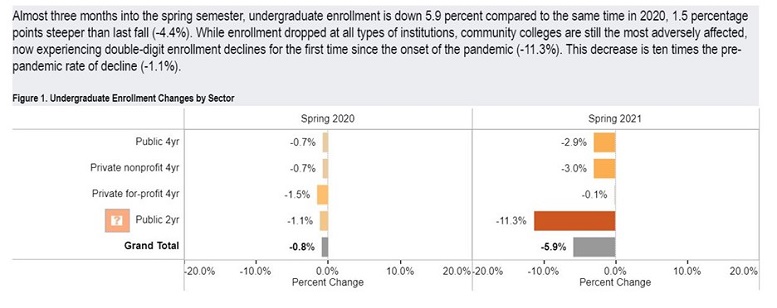Spring undergraduate enrollment is down 5.9% compared to the same time last year, according to the latest research by the National Student Clearinghouse (NSC) Research Center. This is the steepest decline in undergraduate enrollment since the beginning of the pandemic.
Undergraduate enrollment fell further across all institution types, with community colleges experiencing a double-digit decline for the first time during this pandemic, -11.3% compared to -9.5% last fall.
Overall postsecondary enrollment is down -4.2% from a year ago, while graduate enrollment continued to grow 4.4% nationwide. The research released April 28 is based on data as of March 25, 2021, reflecting 12.6 million students and 76% of institutions that report to NSC Research Center.
Associate degree enrollment saw a -10.9% drop and bachelor’s degree enrollment declined -2.2%. Meanwhile, master’s and doctoral degree enrollments are up 5.2% and 3.6%, respectively. And at primarily online institutions, where more than 90% of students enrolled exclusively online prior to the pandemic, both undergraduate and graduate enrollments increased more than the pre-pandemic rate of growth.
“The continuing slide in community college enrollments is of great concern,” NSC Research Center Executive Director Doug Shapiro said in a statement. “In a sign of potentially long-lasting impact on the level of skills and credentials in the workforce, there is still no age group showing increases at community colleges, even after a full year of pandemic and related unemployment.”

Other research results
Traditional college-age students, particularly those aged 18 to 20, saw the largest decline of all age groups (-7.2%), though 18- to 20-year-olds make up the largest share of undergraduates overall (40.9%). The decline was especially pronounced at community colleges (-14.6%).
By race and ethnicity, Native Americans continued to experience the greatest decline of any racial and ethnic group among undergraduates, having dropped -13% this spring. Declines are smallest among Asian students (-4.8%), while White, Black and Latinx students fell by roughly equal levels (-8.5%, -8.8% and -7.3%, respectively). The largest enrollment swing occurred for Latinx students at both community colleges (1.7% last spring vs. -13.7% this spring) and public four-year colleges (2.1% vs. -1.9%).
At community colleges, only Latinx enrollment grew before the pandemic.
Male undergraduates are increasingly falling behind their female counterparts, but primarily online institutions have been the only exception. This spring, male undergraduate enrollment is up 3.5 % at these institutions, compared to 1.4 % for female enrollment.
In terms of majors, enrollment in health professions and related clinical sciences programs fared the best this spring among the top five most common major fields for those pursuing associate degrees (-3.7%) and undergraduate certificates (2%). Among the top 10 bachelor’s degree programs, psychology, computer and information sciences and support services, and education majors increased more than health-related majors.

